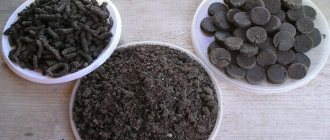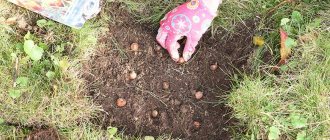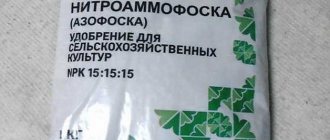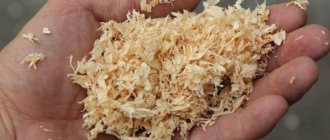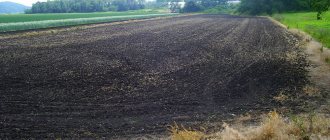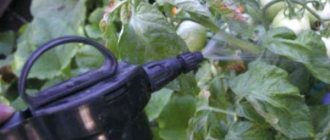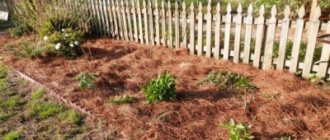History of creation
The developer of the tool is Vladimir Vasilievich Fokin. Agriculture was not his main activity, rather a hobby. The flat cutter was developed by Vladimir Vasilyevich after a heart attack, when work on the site was especially difficult for him.
The idea of creating a hand tool came to Fokin after he saw its machine version in the field - a small wheeled tractor pulling a triangle with a sharpened edge that cuts weeds. Initially, the very idea of this method of soil cultivation belongs to Maltsev and Ovsinsky. The latter borrowed the idea from the Chinese, who had been using horse-drawn cutters in their agriculture for hundreds of years.
Fokin tested his design for more than 7 years and only then received a patent (No. 2040133). Mass production was undertaken by one of the enterprises in Vladimir (Sudogorsk RTP), for which it was subsequently awarded diplomas from the Regional, International and All-Russian exhibitions (Moscow).
Some write negative reviews about flat cutters. This is due to the fact that people have not mastered the technique of working with tools and do not trust the moldless method of farming. Those who use it correctly are quite satisfied.
Information about the inventor
V.V. Fokin is a versatile personality. His intellect combines the talents of a journalist, engineer and gardener. He lost the ability to work normally in the garden after he suffered a heart attack. Disability forced the designer to think about easing physical labor in the garden.
V.V. Fokin studied the behavior of existing soil cultivation tools and analyzed the advantages and disadvantages. By experimenting with different variations, he managed to create a universal tool, which was dubbed a flat cutter. The tests were carried out by the author himself on his own large plot.
What kind of instrument is this
A hand-held flat cutter is a metal plate (bracket) curved in the shape of a poker. One end is attached to the handle, the other (the working part) is immersed in the ground. The working part is sharpened on both sides and obliquely at the end.
Flat cutters replace several tools at once. This is a collective name for similar structures, modified for different types of soils and cultivated crops, but with the same operating principle.
Tool characteristics
The flat cutter includes several garden tools in its design (small shovel, rake, scythe and others). This versatile equipment allows you to perform a significant number of different gardening tasks. Working with a hoe saves physical effort and time .
- The shape of the tool is a metal plate bent in a specific way, the three edges of which are sharpened. There is a choice on the market between a large and a small flat cutter. The first is intended for shaping, hilling the bed, as well as for getting rid of weeds or mowing grass. The second facilitates the work of weeding or forming furrows for sowing.
- The main feature is the ability to remove weeds using a blade. The tool destroys unwanted grass without turning over the soil, which preserves the soil structure and beneficial microorganisms. The roots of the weeds remain in the soil and rot.
- Before you start using the equipment, you should individually adjust it to your height and working style, and also understand the capabilities and scope of action. When assembling the flat cutter, you need to screw two fasteners to the wooden handle.
Product types
There are six original types of Fokine instrument:
- A large flat cutter is used to prepare the soil for planting crops. With its help you can loosen the soil at a depth of 15 cm, hill up and carry out weeding.
- A small tool is used for quick work in soft soil. This species is suitable for weeding between rows.
- The strong hoe is suitable for cultivating heavy clay soil. Its blade is slightly wider and shorter than the standard one.
- “Moguschnik” is a flat cutter with a wide plate, suitable for high hilling.
- Large and small pad. The first is needed for working in large areas with crops, the second is for weeding between rows of cultivated plantings.
Principle of operation
The Fokina flat cutter is an unusual tool used for non-traditional farming. The essence of the idea: the productivity and structure of the soil will become much higher if you stop disturbing its deep layers and thus destroying the worms.
In untouched soil, they successfully perform the function of loosening and fertilizing. The tool knocks down weeds to a depth of 5-7 cm, this is enough to stop feeding the roots. Plant remains rot and worms carry them underground. The shovel turns over the fertile layer along with the worms, disturbing the soil biosystem. The earth becomes vulnerable to wind and sun. For protection it is necessary to use mulching, but this is difficult to implement over large areas.
The device developed by Fokin does not turn over the soil. The blade cuts its top layer, cutting weeds, saturating it with oxygen, but without disturbing the natural structure.
Types of flat cutters and their application
There are 3 main types of flat cutters used in agriculture:
- Small – for cultivating narrow row spacing in beds with carrots, beets, and strawberries.
- Medium – universal.
- Large – for leveling boundaries, cultivating potato fields, tree trunks of fruit trees and shrubs.
There are several modifications of the tool:
- “strong” - a shortened working blade for dense soils (clay, loam);
- “small weed” and “large weed” - a narrow, long working part, convenient for removing weeds;
- “Mighty” - a wide blade for high hilling of large plants (potato field) and clearing of boundaries.
Flat cutter "swift"
The working part is made in the form of two blades connected in the shape of a heart, an oval, a square frame or a drop pointed at the bottom.
What is a “swift” for?
- removal of large weeds with a developed root system;
- loosening the soil;
- cutting off the mustache of strawberries and wild strawberries.
"Strizh" copes well with cutting weeds and cleaning hard-to-reach places in the tree trunks of shrubs. The handle should be of sufficient length so that you do not have to bend your back when working.
LiveInternetLiveInternet
History of invention
The modern hand-held flat cutter was invented by Vladimir Vasilyevich Fokin, a man who devoted himself completely to any business, no matter what he did. He worked at the plant, making a significant contribution to it with his rationalization proposals, as a responsible and hardworking person.
On the collective farm, Vladimir Vasilyevich performed many duties, worked as a journalist for the Leninets newspaper, communicating with agricultural workers during his service. In addition to work matters, Vladimir Fokin loved to work on the land; from his youth he was interested in this fascinating, and at the same time physically difficult occupation, and had extensive experience in this field.
But life changed after a heart attack, when Vladimir Vasilyevich worked in the city of Sudogda in a highly paid but very harmful job as an operator of a fiberglass production workshop. Disability crossed out active work; physically difficult tasks were no longer possible. And the previously thought out ideas of making labor easier on the land and the agricultural tools improved by Fokin were not so easy to work with that you could do what you loved.
However, long and persistent study of garden tools, many attempts to make an easy-to-use and effective tool for cultivating the land were crowned with success, the result of which is the Fokina manual flat cutter. With the help of this tool, Vladimir Fokin could cultivate a plot of 40 acres. This invention of Vladimir Vasilyevich now helps millions of gardeners to significantly facilitate work on the land, significantly reducing physical activity, while at the same time, when using natural agricultural technology, soil fertility increases, and therefore productivity.
What is a manual Fokina flat cutter?
The Fokina flat cutter is an unusual gardening tool; in addition to its main purpose - weeding and loosening, it can perform up to two dozen operations on the ground. The main work of the flat cutter is to cut or pull out weeds when its blade passes parallel to the soil surface at a depth of 2 to 5 cm. That is, the top layer of soil remains in place and is loosened without turning the layer. And such cultivation of the soil preserves its structure and is harmless to the inhabitants of the living world of the soil, requiring less effort and time. However, a flat cutter is not a traditional farming tool and its use instead of a hoe only makes sense when weeding, and in dense, structureless soil (due to digging with the turnover of the layer), it will not work very easily. On soil that has a porous structure, as well as a mulching ground cover layer, it is easier and more efficient to work with a flat cutter, while at the same time, using a flat cutter in combination with other natural farming methods improves the condition and increases the fertility of the soil.
Fokin's manual flat-cutter consists of a plate bent in the form of a bracket at certain angles, the three cutting surfaces of which are sharpened. The blades of the cutting part of the flat cutter should always be sharpened to reduce resistance to the soil and the plants being cut.
An exception to sharp sharpening of the blade may be the case when the weeds are young and their stems have not yet become strong, and the flat cutter does not cut them, but pulls them out along with the roots.
At this time, there are six varieties of Fokin flat cutters: these are small, large flat cutters, “Krepysh”, “Moguschnik”, “Small Polotik” and “Big Polotik”. The most popular are two flat cutters, which are included in the “Universal Kit”: a small flat cutter is designed for quickly and accurately weeding beds, thinning out dense seedlings, and cracking the soil; large - for forming, preparing and hilling beds, weeding, mowing grass, etc.
The Krepysh flat cutter has the same dimensions as a large flat cutter, but has a shortened blade, making it easier for them to work on heavy clay soils. “Moguschnik” has a wider blade than a large flat cutter and is used for high hilling of plants. “Weeders” are analogues of small and large flat cutters, respectively, but their blades are longer and narrower and are used for quick weeding of an area.
The flat cutter is attached to a flat-shaped wooden handle, the cross section is a rectangle with rounded edges. Such a handle allows you to easily work with a flat cutter, holding it in any required position, and without rubbing calluses.
A large flat cutter should be mounted on the handle so that it is convenient for them to work. It can be fixed in two positions by changing the angle of inclination, using the holes existing in it and the handle, and relative to its location on the handle in two more - inside or outside, which will make it easier for left-handed people.
Correct operation of a flat cutter is a movement parallel to the surface of the earth. If the angle of inclination of the flat cutter when moving towards you is directed upward, towards the surface of the earth and you have to bend over for normal operation, you need to change the angle of attachment - it will decrease relative to the handle, and if the blade tends downward when pulled, burrowing into the ground, then you need to fasten the flat cutter at a large angle to cuttings
When working with a Fokina flat cutter, your back should be straight, with a slight tilt of the body, and you should hold the handle of the flat cutter so that your thumbs “look” up. In this case, working with a flat cutter will be correct and will minimize physical stress.
Types of work performed by a flat cutter
Depending on the position of the cutting edges of the flat cutter, it can perform various operations:
♦ weeding and loosening of beds is carried out using a wide edge of the blade - it enters the soil at the required distance (up to 1 meter) and is pulled towards itself in one movement. Weeding is recommended to be done at the stage when weeds begin to grow, without allowing them to grow, this makes it much easier and easier to deal with them. ♦ the formation of beds occurs as follows: onto a plot of land loosened by a flat cutter, soil is raked from the rows with an inverted flat cutter. That is, the shorter edge of the blade “looks” down and the blade becomes almost perpendicular to the surface of the earth, due to which, when the flat cutter is pulled through, the soil is raked. This operation is performed alternately on both sides of the bed. ♦ leveling the soil surface is carried out by movements either towards oneself or away from oneself with an inverted flat cutter without applying significant effort. Also, in this way, the grooves with the sown seeds are filled with soil. ♦ blows with the narrowest cutting edge of the flat cutter produce deep loosening of the soil, as when working with a plow. ♦ when pulling a narrow edge of a blade buried into the soil, it is cracked, improving aeration, and also thins out dense crops. In the formed bed, grooves are cut for sowing using this method. ♦ if necessary, break up large clods of soil, this is done with the heel of a flat cutter or the cutting edges of the blade. ♦ in order to mow an adult and strong weed, make a blow at the bend of the flat cutter, where the vertical part turns into a horizontal one. And to “digg up” a plant, the flat cutter is buried with the narrow part of the blade under the root and, like a shovel, it is pulled out along with the root (if the root system is shallow and fibrous). You can mow with a flat cutter on small areas of land, or where it is impossible to use a scythe. You can work with one edge or two edges alternately in both directions. ♦ hilling is carried out similarly to the formation of beds; the soil between the rows is raked first on one side of the row, then on the other.
Also, with a Fokin flat cutter you can trim strawberry mustaches, work with hay, use it as a fork, shovel, rake...
Of course, if you need to dig holes, weed too large areas, mow grass in meadows, make hay, etc., then it makes no sense to use a flat cutter. It is not intended for this, although it has such capabilities, but it is worth following common mind and logic. To weed large areas, you can use a weeder with a wheel and a cutting knife - the same as a flat cutter, but already mechanized :)
When using a flat cutter, you need to experiment with how it is more convenient, how best to use it in a given case. Only practice can show all the positive aspects of a flat cutter in comparison with hoes and shovels.
A manual flat cutter is widely used in natural agriculture, facilitating the work of the farmer, thanks to minimal intervention during soil cultivation, it allows you to preserve, restore and increase the fertility of our land - the breadwinner.
More details about the Fokin flat cutter are discussed in this video.
You can purchase Fokin flat cutters from Organic Farming Clubs in your city or region, which will allow you to protect yourself from counterfeits.
https://prirodnoezemledelie.com/ploskorez-fokina/
Types of work performed
Functions of a flat cutter and the tools it replaces:
- mowing weeds. The sharp blade performs well as a scythe, removing weeds to the very root;
- stacking weeds and tops (replaces rakes). The design of the working blade of a large flat cutter is such that it is convenient for them to rake up even heavy plant residues without making any serious effort;
- loosening is shallow and deep. It is better to do this with a large flat cutter - its working blade is slightly curved. In terms of loosening quality, the tool is not inferior to hoes and hoes;
- digging up weeds. It is convenient to pry them off with a sharpened end part;
- cutting furrows and preparing holes for sowing.
The tool is suitable for tedding hay, mixing fertilizers, and cleaning floors in animal stalls.
Modifications and varieties
Over the years of practical use, this newly created gardener's assistant has undergone numerous changes and acquired an enviable range of models that cover the growing needs of users. Let's take a closer look at the types and their differences. Of course, the ideal solution would be to purchase several variations at once, since they are inexpensive and durable :
- Large and small flat cutters. The kit is often sold in pairs, is standard and is intended for daily use over large areas. Traditionally, the “bigger brother” is useful when hilling potatoes or in haymaking, it will allow you to prepare a bed for replanting, and also free fruit trees from weeds in hard-to-reach conditions. “Baby”, with its smaller size, is ideal for more detailed work: if you need to trim the strawberry mustache, loosen the soil without disturbing the emerging seedlings, or thin out excessively dispersed seedlings.
- Sturdy. A shortened, durable tip will make it possible to cope with the most stubborn soil. Neither virgin soil nor frozen or clay soil are afraid of him. Easily breaks apart lumps and lumps. And the main thing is that very little effort is put into it, so it will be the best acquisition for both an elderly person and a teenager.
- Mighty. Featuring a wide cutting blade, this option is suitable for cultivating and hilling tall grass crops. Potatoes, cabbage and tomatoes will first of all appreciate the care and thank you generously.
- Large and small pads. As the name suggests, the main use is weeding gardens. At the same time, narrow long blades allow you to achieve maximum effect in tight greenhouse spaces; pass between rows without affecting useful crops; prepare holes and furrows to drain moisture.
The danger of running into Adibas forces you to be careful in your choice.
How to work
To work effectively, you need to master the technique of how to hold the Fokin flat cutter correctly and how to use it.
- To loosen and trim weeds, the cutting edge is deepened by 4-5 cm and carried underground to the maximum possible distance.
- Don't bend your back.
- The angle of the blade should be such that it is parallel to the surface of the soil.
- When using the tool as a scythe or hoe, the handle is grasped in the same way as a rake. The blade is parallel to the ground (flat).
- If you turn the handle so that the working part sticks into the ground at an angle of 60˚, you will significantly reduce labor costs when cultivating dense soil. Rotating the blade 90˚ relative to the surface transforms the flat cutter into a ketmen, a fork or a plow.
- To reduce the hassle of cultivating the beds, they should be narrow. You can simultaneously rake up the soil from the adjacent boundary and loosen the rows.
Advice from the inventor: the first spring loosening to a depth of 2-3 cm should be carried out immediately after the snow melts. This measure will help to activate the activity of soil microorganisms and accelerate the maturation of the soil for sowing.
How to make a Fokina flat cutter at home
Making it yourself will not be difficult.
Before you start work you need to decide:
- what types of work, in what volumes and on what soils are planned to be carried out;
- what material is available for the work;
- what tools does the master have;
- how many flat cutters need to be made.
Working with electrical appliances and open flames requires caution. Safety precautions should not be neglected. A pair of strong gloves and glasses to protect your eyes are a must.
After preparing everything you need, you can start working. By doing everything step by step, you can achieve good results and get a simple but useful tool.
Selecting metal for a flat cutter
The main part of the flat cutter is the metal part. How long you can choose the right metal, the more durable the tool will be. For production you will need a strip 4 - 4.5 cm wide and 40 -45 cm long.
What will suit the metal part:
- steel angle sawn lengthwise;
- car spring, 5-7 mm thick.
High-alloy steel is the best option. Tools made from this material are durable, resistant to corrosion and do not require frequent sharpening.
It is advisable to choose a stronger metal. In order to make it more pliable in processing, it is “released”. Having heated the plate on a blowtorch to the color of a ripe cherry, it is allowed to cool slowly. This “tempering” procedure will allow you to bend, drill and sharpen the workpiece in accordance with the product diagram.
Making a flat cutter blank
Finding a piece of suitable metal will not be difficult. There are services that are ready to send steel plates of the required size and steel grade.
If the steel is high-alloy, for ease of working with it, it must first be “released”. After this procedure, the metal will be more pliable and easier to work with.
The entire process of manufacturing a flat cutter can be divided into several stages:
- We give the workpiece the required shape in accordance with the dimensions.
- Let's mark the detail.
- We mark the locations of the technical holes and the places where the plate bends.
It is convenient to bend the plate by holding it in a vice. It is better to preheat the areas of the plate where bends are planned.
Using precise blows of a hammer, give the plate the required angles:
- The first fold should be 90 – 100 degrees;
- second – 110˚ – 120˚;
- third – 110˚ – 120˚;
- the fourth fold is adjusted to the junction with the handle.
It is better to bend the plate in this sequence, otherwise it will be very difficult to make the fourth fold. This is how all models of flat cutters are made, the only difference is the width and length of the segments between the folds of the product. You need to bend the metal slowly, periodically checking the angle with that indicated in the drawing. Avoid bending and reverse actions - this may break the bend and the workpiece will have to be thrown away.
In accordance with the diagram, technical holes are marked and drilled. They should be located at a distance of 5 - 7 mm from the edge of the workpiece. The diameter of the holes depends on the width of the plate, the number of mounting bolts and the model of the flat cutter.
Assembly diagram of a flat cutter
It is best to prepare the necessary parts and assemble the flat cutter in stages and in accordance with the diagram and instructions, which should be prepared in advance. A drawing indicating the dimensions of the plate, bend locations, number and diameter of holes will speed up the work and help avoid mistakes when assembling the structure.
To manufacture and assemble a flat cutter you will need the following tools:
- electric knife with replaceable circles;
- drill with a set of drills;
- vice;
- large and medium hammer;
- blowtorch;
- plane;
- sandpaper.
The handle for the flat cutter should not be round. A rectangular blank with rounded edges is easier to hold in the hand and makes the fastening unit for the metal part strong and reliable.
If you have the material, a detailed drawing and the necessary tools, it will take 3 to 4 hours to make the tool. You can use it for more than one season. A self-made flat cutter will make all work in the garden easier and will be a source of pride for the master.
Specifications
The products are made from spring steel grade 65G. The small blade has two mounting holes on the part adjacent to the handle, and the medium and large blades have three each (in a triangle): one at the top and two at the bottom.
Depending on which of the lower holes the bolt is screwed into, the angle of inclination of the working blade changes. Bolts and nuts are included in the kit.
The stalk is flattened on both sides (quadrangular in cut). It is made from durable and light tree species: larch, ash, linden, birch. The length is selected individually according to the person’s height. For example, for 1.8 m, the cutting height will be 1.3 m.
You can use one handle for different instrument models. To replace, just unscrew the nuts and rearrange the blades.
Advantages and disadvantages
Advantages of a flat cutter:
- replaces several tools at once;
- increases soil fertility;
- the flat handle prevents your hands from slipping, preventing the formation of calluses;
- speeds up the process of cultivating land while reducing labor costs.
The only disadvantages that can be noted are the need to adapt to the design and master the operating technique. Not everyone succeeds in this, as a result of which this unusual device turns out to be unclaimed in the arsenal of country tools.
How to distinguish from a fake
Counterfeit instruments seriously spoil the reputation of the original ones. The blades bend, burst, are not securely fastened, and quickly become dull.
Features of the original product:
- the working blade is black, well sharpened;
- between the mounting holes the letter “F” is engraved or there is a transparent sticker with the inscription in white letters “Fokina Sudogorsky flat cutter”;
- the working part does not bend, does not bend when pressed with hands or when pressed on the floor.
You can check the strength of steel by hitting the sharpened edge with a metal object. If there is a notch, the steel is soft and the tool is of poor quality.
The original instruments (sold in twos - large and small) are equipped not only with rust-coated bolts, but also with an instruction brochure from the author of the product called “To the Earth with Science.” It describes in detail the principle of organic farming and soil cultivation techniques.
About the real Fokin flat cutter
There are many different tools on sale that are similar to Fokin’s flat cutter: “Strong”, “Powerful”, “Hydra”, “Bee”, “Guardian”, large and small canvases, a large modernized flat cutter and others. But Vladimir Vasilievich Fokin created only two types: large and small.
FLAT CUTTER - IN YOUR HANDS
Flat cutter for basic soil cultivation and all work - LARGE, consists of an elongated blade, a handle and two bolts.
Flat cutter for “gentle” work and very fast weeding - SMALL, consists of a shortened blade, a handle and two bolts.
The tools can be “customized” to suit your height and working style... To do this, the small flat cutter has 2 options for attaching to the handle (by attaching the handle to the bracket with one or another supporting surface). The large flat cutter has 4 mounting options (two additional ones due to the third hole in the bracket).
A “tuned” flat cutter allows you to dramatically reduce the previously small physical effort during deep tillage, loosening and hilling.
A manual flat cutter performs the functions of almost all garden tools without readjustment. The performance of a particular function depends on how to take the cutting in your hands and what kind of work method to perform.
Fokin V.V.
The book “To the Earth with Science”, published in the “Researcher” library, https://ligis.ru/librari/2586.htm
Today, sellers impose on us their criteria of authenticity, which are visual and attractive to us. Among them is a colorful brochure.
Such a brochure, complete with flat cutters, is considered proof of authenticity
And also a sign of authenticity is a stamp-engraving on a flat cutter in the form of the letter “F”, and sometimes a sticker “from Fokin himself”.
Another sign of the authenticity of the flat cutter is the letter “F”
The engineer-inventor died in 2002, and he can no longer make engravings and stickers. Even the text of V.V. Fokin in the brochure included in the kit has been changed.
Spread of the modern brochure “To the Earth with Science” from the set: the text from Fokin’s book has been changed - descriptions of similar tools have been added
Until 2002, a real instrument could be bought from Fokin himself. Today, genuine Fokina flat cutters are manufactured by Sudogodskoe RTP JSC. It was this enterprise, located at the place of residence of the inventor, that undertook to produce a new product of those years. The official website gives advice: you can determine the authenticity by the invoice and trademark on the product - No. 200829. It is called “Fokina Flat Cutter” and nothing else.
This does not mean that all flat cutters from other manufacturers are bad. They simply cannot be sold under the promoted brand “from Fokin”. For example, I don’t have the original, it was sold in a local store, under the honest price tag “Large modernized flat cutter, 1 piece.” That is, the surname Fokin is not used. We bought it 5 years ago, today (2019) it costs 205 rubles. I like the tool, I never leave it on my property, especially in the spring, when the season of gardening and sowing arrives.
How to choose the right one
The choice of tool depends on the density of the soil and the type of area being cultivated. For hard soils, a “strong” one is suitable; for soft soils, any modification of a “swift” is suitable.
If the area is very overgrown, you can clean it with a “large weed.” For processing ordinary beds, its small version is sufficient. The original set of Fokin flat cutters, consisting of small and large blades, is universal. With their help you can treat any area.
Sharpening and caring for a flat cutter
Despite all the unpretentiousness and wear resistance of the Fokin flat cutter, seasonal inspection should not be neglected. In a situation where it is necessary to renew the sharpness of the blade, a file, emery or a sharpening wheel are equally suitable. Wiring should be carried out from tip to base, measuring by eye an angle of forty-five degrees. An owner who cares about his things will not be too lazy to treat a freshly sharpened flat cutter with an anti-corrosion agent for the winter, then the tool will last longer.
When performing the same procedure with electrical equipment, it is necessary to take into account, among other things, the minimum pressure that does not cause overheating with the inevitable decrease in strength.
DIY making
You can make a Fokina flat cutter yourself. To do this, you will need a welding machine, metal plates and pipes, a blowtorch, a grinder and a grinding wheel.
Procedure:
- Heat the steel with a blowtorch until red hot and cool.
- Using a grinder, cut a piece of canvas to the required size.
- Fix the workpiece in a vice and, heating it with a blowtorch, give it the desired shape with a hammer.
- Drill holes and sharpen blades.
A drawing of the working part of the tool is shown in Figure 1.
The cutting production diagram is shown in Figure 2.
The process of tillage can be significantly accelerated if you attach the tool to the walk-behind tractor as an attachment. A lightweight option: purchase ready-made working parts (blades) and fix them on the frame.
How to make a flat cutter attached to a walk-behind tractor is shown in diagrams 1 and 2.
Scheme 1. Working element (blade)
Scheme 2. Drawing of a prefabricated flat cutter for a walk-behind tractor for DIY production
To ensure the required immersion depth (5-7 cm), you need to attach any weight (a bag of sand) to the frame of a flat cutter with a ripper for a walk-behind tractor.
How to sharpen, straighten and store a Fokina flat cutter
You can sharpen the Fokin flat cutter using:
- emery;
- drills with a special attachment;
- a regular abrasive stone or sandpaper wrapped around a wooden block.
The Fokin flat cutter is sharpened along three edges (two sides of the knife and the tip) plus a bend that goes from the handle to the blade. It is also the cutting working part of the tool. The bevels are on the outside, they are ground, the sharpening angle is 40–50 ° to the inner surface.
Sharpening of the Fokin flat cutter is carried out from the outside along three edges, including a bend, a block or a circle; only the chamfers and bevels need to be ground
When sharpening on a rotating sanding wheel, the pressure should be minimal to prevent heating of the cutting edge. Otherwise, it will lose its original hardness, become brittle and will not be able to withstand the same loads.
When sharpening on an emery wheel, the pressure should be minimal
After sharpening on an emery wheel, the blade needs to be corrected - to remove the resulting nicks and burrs. To do this, use a block or file with flat edges.
The flat cutter is adjusted with a block, gets rid of burrs, and aligns the blades
It is easy to work only with a sharp flat cutter, and in order for it to remain that way, it will have to be adjusted frequently between sharpenings. Constantly monitor the condition of the cutting edges. If small nicks have formed, walk with a block, holding it at the recommended angle of 40–50°. When straightening no longer helps to align the blades, sharpen the flat cutter as described above.
Video: sharpening the Fokina flat cutter
At the end of the season, the flat cutter should be stored in a dry place: barn, storage room, garage. Before doing this, clean it of dirt; it is advisable to lubricate the blades with machine oil.
I store my flat cutter along with all the tools. I collect rakes, hoes, shovels and take them to the barn, under lock and key. I don’t lubricate the blades, I’ve never seen rust on the flat cutter, although it’s been in the open air for the entire warm season, near irrigation barrels.
Sharpening rules
Usually, the original Fokin flat cutter does not need sharpening. The blades are aligned at a precise angle, and the steel is hard enough so that this angle does not become dull. But in some cases it is still necessary to sharpen the working surface.
You need to sharpen the bevel facing the ground, do not touch the front surface. The optimal angle is from 40 to 45˚. The blade width should be 1-2 mm. You can sharpen either on a wheel or with a whetstone. The main rule in this case is not to overheat the surface, as this will lead to a decrease in the strength of the steel.
History of invention
Designed an innovative garden tool by V.V. Fokin is a man who has tried himself in a variety of guises. He also had experience working as a designer at a machine-building plant, but then Vladimir Vasilyevich moved to the countryside, became interested in gardening, became interested in the problems of agricultural technology, and grew vegetables on his own plot.
He was prompted to invent a flat cutter by a sad event - Vladimir Vasilyevich suffered a massive heart attack, and after that there was no question of returning to his previous physical activity - doctors strictly prohibited intense physical activity. But Fokin was not going to put up with this, nor was he going to give up growing homemade, organic vegetables in the garden. He decided to come up with a tool that would allow him to do work in the garden quickly, without putting in excessive effort. By this time, the inventor was already retired against his will, so he took up the matter with enthusiasm, which he later infected his entire family with.
But obtaining a patent was still a long way off. Work on the flat cutter dragged on for several years until it acquired the appearance that is now known not only to Russian summer residents, but also to gardeners in the CIS countries and abroad. First, the inventor showed the new tool to his relatives and friends, and Vladimir Vasilyevich’s neighbors also tried to work with it. And the flat cutter was highly rated by everyone. Only after this Fokin patented his invention and launched the production of the innovative instrument. In 2002, Vladimir Vasilyevich died, but the flat cutter he invented is still in high demand among gardening enthusiasts and makes their hard work easier.
Unlike a conventional hoe, the Fokin flat cutter can perform a variety of types of work; it can replace a whole range of gardening tools. However, there are many people who were not able to use the full potential of the Fokin flat cutter. Some lacked knowledge, others lacked patience. When starting to use any new tool, conclusions about its advantages and disadvantages can be drawn only after you have developed certain operating skills. This concerns the Fokin flat cutter to a greater extent than any other tool. You need to prepare to work with it, adjust it in accordance with your height, learn how to change the adjustment parameters of the cutting part depending on the type of work being performed. Only then will you be able to fully exploit the potential inherent in the design of this invention.
Fokina combined flat cutter, modernized

